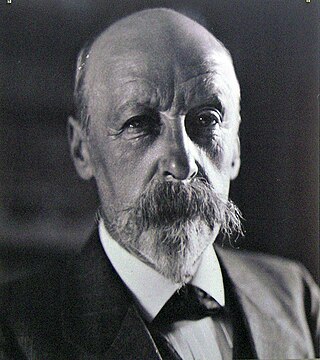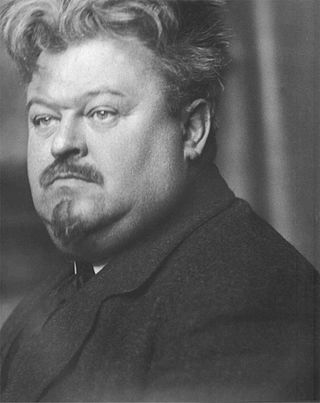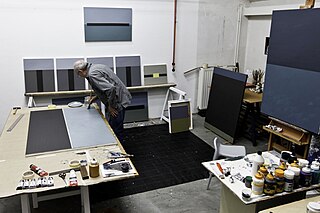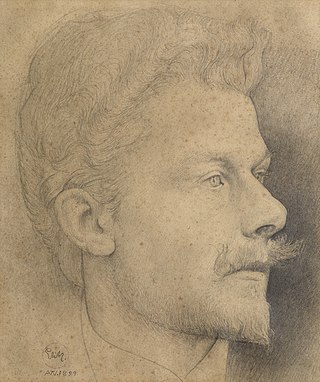
Luc Tuymans is a Belgian visual artist best known for his paintings which explore people's relationship with history and confront their ability to ignore it. World War II is a recurring theme in his work. He is a key figure of the generation of European figurative painters who gained renown at a time when many believed the medium had lost its relevance due to the new digital age.

Emile Claus was a Belgian painter.

Knight Jan Hoet was the Belgian founder of SMAK in Ghent, Belgium.

James Sidney Edouard, Baron Ensor was a Belgian painter and printmaker, an important influence on expressionism and surrealism who lived in Ostend for most of his life. He was associated with the artistic group Les XX.

Guillaume Bijl is a Belgian conceptual and an installation artist. He lives and works in Antwerp.
Kati Heck is a German artist based in Antwerp. Though her work spans sculptural installation, short film, and photography, she is best known for her large-scale paintings.
Hans Vandekerckhove is a Belgian painter, living and working in Ghent. From 1975 to 1997 Vandekerckhove studied Art History at University Ghent, where he wrote his graduation thesis on David Hockney.

Adelbert Van de Walle (1922–2006) was a Flemish-Belgian architect, art historian and professor in the History of Art and Archaeology at the University of Ghent (UGent).

The Mu.ZEE is a museum in Ostend, Belgium, specializing in Belgian art from 1830 onwards. It was created in 2008 by the fusion of the former Provinciaal Museum voor Moderne Kunst and the Museum voor Schone Kunsten Oostende, both located in Ostend. The museum has two dependencies, the Ensorhuis in Ostend, and the Permekemuseum in Jabbeke. Mu.ZEE is an abbreviation of "Kunstmuseum aan Zee".
Koen van den Broek is a Belgian artist who lives and works in Antwerp and Seoul, South Korea.

Valerius de Saedeleer or Valerius De Saedeleer was a Belgian landscape painter, whose works are informed by a Symbolist and mystic-religious sensitivity and the traditions of 16th-century Flemish landscape painting. He was one of the main figures in the so-called first School of Latem which in the first decade of the 20th century introduced modernist trends in Belgian painting and sculpture.

Reniere & Depla is a Belgian artist duo, consisting of Paul Reniere and Martine Depla. Together they paint primarily with acrylic paint on canvas and wood panel. They have curated exhibitions in Belgium and France, showing the works of [Berlinde De Bruyckere], [Hans op de Beeck], and other celebrated Belgian artists. In 2018, they organised the first edition of Art Autun, a biennale of contemporary art in Autun. Their common career as artists began in 1995. They live and work in [Watou] and Autun. Like a growing group of contemporary artists they use photography as source material for their work.
Peter Van Gheluwe is a Belgian artist, known for his paintings, drawings and spatial work. Works of Van Gheluwe are part of collections such as those of the Flemish Community, the National Bank of Belgium, Mu.ZEE Ostend and the city of Aalst, along with private collections in Belgium and abroad. He was married twice and has three sons. He currently lives and works in Scheldewindeke.

Theodoor Verstraete, also spelled Theodor Verstraete and Théodore Verstraete was a Belgian Realist painter and printmaker who is known for his landscapes depicting life in the countryside as well as his paintings of the Belgian coastal landscape. He has been called the 'poet of rural life' who depicted the humble life of the people in the countryside with empathy.

Luc Piron is a Belgian artist. He is a painter and printmaker. He is also a photographer and experiments with the possibilities of computer art.

Flemish Expressionism, also referred to as Belgian Expressionism, was one of the dominant art styles in Flanders during the interbellum. Influenced by artists like James Ensor and the early works of Vincent van Gogh, it was a distinct contemporary of German Expressionism. Contrary to the more rebellious and erotic nature of many German Expressionist works, the Flemish art of the School of Latem was more oriented towards the farming life, and was expressed in earthy colours and vigorous brushwork. It was also in general more oriented towards France and Brussels than to Germany, and incorporated elements of Fauvism and Cubism, for example the interest in "primitive" art, of both the ethnic and folk traditions. Flemish Expressionists like Spilliaert were more influenced by Ensor and Symbolism, or like Wouters were closer to the vibrant colours used by the Fauvists. The main proponents were Gust De Smet, Constant Permeke and Frits Van den Berghe.

Victor Lagye was a Belgian painter and illustrator best known for his genre paintings and history scenes. He participated in various decorative programs commissioned by the Belgian government. In his later years he was active in art education.

Philippe Vandenberg (1952–2009) was a Belgian painter.

Charles Mertens, Karel Jozef Mertens or Karel Mertens was a Belgian draughtsman, painter, muralist, etcher and illustrator. He is known for his portraits, landscapes and genre scenes. He painted many scenes with fishermen and fishing boats.















